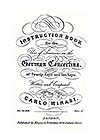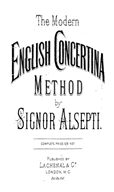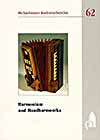“Anweisung das Accordion zu spielen”
(Instructions for Playing the Accordion).
published by Johann Gottlieb Höselbarth
Johann Gottlieb Höselbarth published this tutor in Chemnitz Germany, in the late 1830s
or early 1840s. The original document is in the Musikinstrumenten-Museum, Berlin,
where it accompanies a 20-key concertina, Kat.-Nr. 5171, attributed to Carl Friederich Uhlig (the
inventor) which they date to c. 1835. That concertina is very similar to one in the collection
of Stephen Chambers that is internally signed ‘Höselbarth’, and it may be that the Berlin
instrument is also by him, and somewhat later than the date suggested. The tutor does not include a date of publication,
but Maria Dunkel1
has dated it to c.1837. However it has since been established that the first directory
entry for Höselbarth is in 1840.
It is unclear who wrote the Höselbarth “Instructions …”. It has been suggested that the author may
have been Johann David Wünsch (1814–1895), a musician in the Chemnitz town
orchestra who married Uhlig's daughter Christiane Caroline in 1840, and who was
involved in “Harmonika” (i.e. German concertina) building at that time. In 1890 Wünsch wrote that
he was the author of some early
tutors for the instrument2,
and it is thought this may have included the one published by Höselbarth.
The Höselbarth publication is small (4 1/2" x 5 1/2") with only 15 pages, and it may have
been supplied with his concertinas (as the title of the tutor suggests, the instruments
were first called “Accordions” by the
Chemnitz makers3,
though for much of the nineteenth century, and into the twentieth, German concertinas were
best known in their homeland as
“Harmonikas”4,
a name which is still sometimes used for them today). The
fingering chart on pp. 2-3 is for a single-row concertina in the key of C, followed by
seven pieces for that instrument on pp. 4-9, but there is then an Appendix of tunes for the
two-row instrument5
in the keys of C and G, on pp. 10-15.
All of the music in this tutor is in the key of C, and several of the tunes in the Appendix
include modulation between the keys of C and G. Cross-row fingering between the C and
G rows is used in the first notes of the melody of the March on page 13, and elsewhere in
the tutor. Chords are typically rich, with up to four notes played at once on the left hand.
None of the chords are cross-row fingered.
The tunes are comprised of a mixture of Lutheran chorales/hymns and popular dance music,
including polkas, schottisches, waltzes and marches. The schottische included in the tutor
is an early representative of this type, as this dance form first appeared (in 2/4
“polka” time), in Germany, only around 1840.
All of these tunes are in the harmonic style, where the melody is played on the
right hand, and the chorded accompaniment is played (mostly) on the left. This and an
early tutor by Carlo Minasi
published in London by 1846 (see elsewhere on this site)
indicate that the harmonic style of playing dates back to the earliest days of the German
concertina, which soon evolved into both the Anglo-German and Chemnitzer concertinas,
as well as the Carlsfelder concertina and the Bandonion. Both the
Anglo concertina and the German systems are still played in a melody-right, chords-left style.
The Anglo concertina retains the two C/G rows of the early German concertinas, and thus
the fingering annotations that accompany the tunes are easily readable by Anglo players
today. The original Chemnitz keyboard was extensively modified in the nineteenth century, and as a
result the fingering annotations would not be instantly readable by today’s Chemnitzer players.
Two of the arrangements of tunes included within this tutor were later used in their entirety by Carlo
Minasi in his 1846 tutor, without attribution: “Der König segne Gott”, p. 12, known in
England as “God Save the King (or Queen)”, and “Vor deinen Thron tret ich hiermit”, p. 5. This
practice was not unusual in the nineteenth century, as Randall Merris has discussed
in the introduction to his bibliography
of concertina tutors; indeed the name of the author was not even
included in the Höselbarth tutor.
(We would like to thank Bernd Wittenbrink of the Bildarchiv and Phototheque,
Staatliches Institut für Musikforschung, Preußischer Kulturbesitz, Berlin,
for a copy of the partial document in their collection. The final two pages
have been supplied from copies belonging to Stephen Chambers.
Thanks also to Dr. Dieter Krickeberg, who
first brought to our attention the Höselbarth “Anweisung das Accordion zu spielen”,
and to Peer Ehmke at the Schlossbergmuseum, Chemnitz, who researched
the Chemnitz makers in connection with the Museum's exhibition "Sehnsucht
aus dem Blasebalg" and provided photocopies of much German source material.)
Translation
Page 1.
Instructions for playing the Accordion.
Also for those who do not read music.
Published by J. G. Höselbarth in Chemnitz.
Page 2.
Fingering Chart for the Accordion.
Left Hand.
Claves = keys or buttons.
Aufziehen = draw
Zudrücken = press
Numbers below the staves are for the left hand, and those above the staves are for the
right hand.
The sign ^ indicates press,
the sign (+)
indicates that the air valve (vent) should be opened,
and the sign _ repeats the preceding number.

Page 3.
Right hand.
Ventil den Balg zu öffnen = Air valve to open the bellows
Because the instrument is airtight, it is injurious to open or close the bellows without opening the
air valve or pressing a button.
Page 4.
God, who madest earth and heaven.
Now all the woods are sleeping.
Page 5.
Before Your throne I now appear.
Page 6.
God Save the King.
March.
Page 8.
Schottische.
Page 9.
Tyrolean Waltz.
Page 10.
Appendix.
For the two row Accordion.
Abide among us with Thy [grace].
Page 11.
Polka.
Page 12.
Galop.
Page 13.
March.
Read or Download the Whole Document in a Single File
-
 Anweisung das Accordion zu spielen
[Instructions for Playing the Accordion]
Anweisung das Accordion zu spielen
[Instructions for Playing the Accordion]
-
published by Johann Gottlieb Höselbarth
-
Johann Gottlieb Höselbarth published the earliest-known tutor for the German concertina in Chemnitz Germany, in the late 1830s
or early 1840s.
All of the music in this tutor is in the key of C, and several of the tunes in the Appendix
include modulation between the keys of C and G. Chords are typically rich, with up to four notes played at once on the left hand.
All of the tunes are in the so-called harmonic style, where the melody is played on the
right hand, and the chorded accompaniment is played (mostly) on the left. This and an
early tutor of 1846 published in London by Carlos Minasi (see elsewhere on this site)
indicate that the harmonic style of playing dates back to the earliest days of the German
concertina
-
Posted 15 August 2005
-
» read full document in pdf (or right-click to download)
Authors
Stephen Chambers
(
)
is a leading authority on the history of the concertina and a collector of early free reed
instruments; he has worked as a music librarian in London and was for many years proprietor
of the venerable John McNeill music store (est. 1834) in Dublin. He has recently moved to Kilrush,
Co. Clare, where he intends to set up a concertina and squeezebox museum with his collection,
and to start manufacturing concertinas.
Dan Worrall
(
)
has played the Anglo and English concertinas for over thirty years, as an amateur hobbyist.
He is the author of The Anglo Concertina Music of William Kimber, published by the
English Folk Dance and Song Society in 2005.
His current interests include studying various styles of Anglo playing as well as learning
the art of concertina construction. An earth scientist by training, he holds a Ph.D.
in geology from The University of Texas at Austin. He recently retired from a career
in petroleum exploration and research, and lives with his wife on a farm in the Brazos
River valley of southeastern Texas, where he raises cattle and is an avid gardener.
They have two children.























